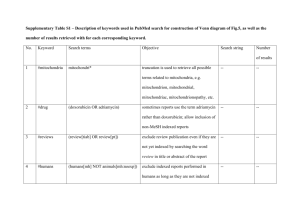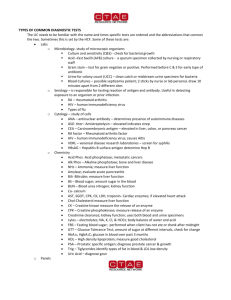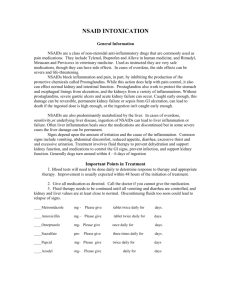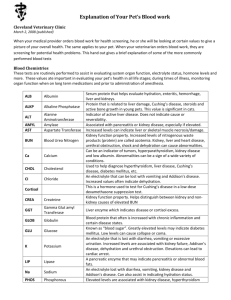C E OOPERATIVE XTENSION
advertisement
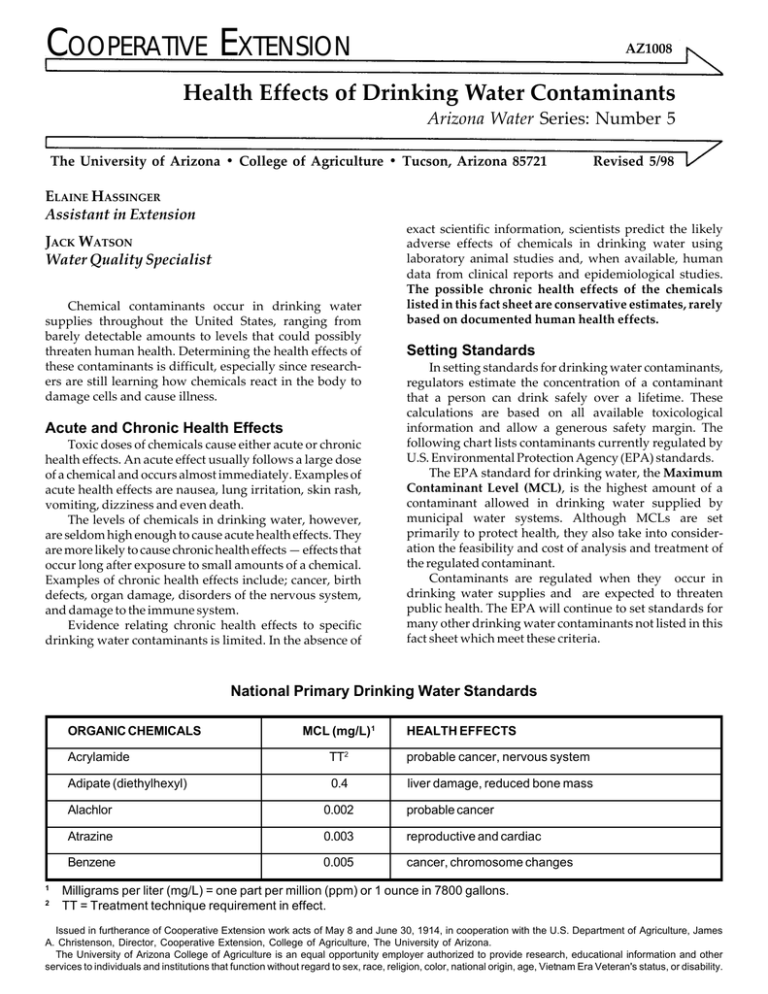
COOPERATIVE EXTENSION AZ1008 Health Effects of Drinking Water Contaminants Arizona Water Series: Number 5 The University of Arizona • College of Agriculture • Tucson, Arizona 85721 Revised 5/98 ELAINE HASSINGER Assistant in Extension JACK WATSON Water Quality Specialist Chemical contaminants occur in drinking water supplies throughout the United States, ranging from barely detectable amounts to levels that could possibly threaten human health. Determining the health effects of these contaminants is difficult, especially since researchers are still learning how chemicals react in the body to damage cells and cause illness. Acute and Chronic Health Effects Toxic doses of chemicals cause either acute or chronic health effects. An acute effect usually follows a large dose of a chemical and occurs almost immediately. Examples of acute health effects are nausea, lung irritation, skin rash, vomiting, dizziness and even death. The levels of chemicals in drinking water, however, are seldom high enough to cause acute health effects. They are more likely to cause chronic health effects — effects that occur long after exposure to small amounts of a chemical. Examples of chronic health effects include; cancer, birth defects, organ damage, disorders of the nervous system, and damage to the immune system. Evidence relating chronic health effects to specific drinking water contaminants is limited. In the absence of exact scientific information, scientists predict the likely adverse effects of chemicals in drinking water using laboratory animal studies and, when available, human data from clinical reports and epidemiological studies. The possible chronic health effects of the chemicals listed in this fact sheet are conservative estimates, rarely based on documented human health effects. Setting Standards In setting standards for drinking water contaminants, regulators estimate the concentration of a contaminant that a person can drink safely over a lifetime. These calculations are based on all available toxicological information and allow a generous safety margin. The following chart lists contaminants currently regulated by U.S. Environmental Protection Agency (EPA) standards. The EPA standard for drinking water, the Maximum Contaminant Level (MCL), is the highest amount of a contaminant allowed in drinking water supplied by municipal water systems. Although MCLs are set primarily to protect health, they also take into consideration the feasibility and cost of analysis and treatment of the regulated contaminant. Contaminants are regulated when they occur in drinking water supplies and are expected to threaten public health. The EPA will continue to set standards for many other drinking water contaminants not listed in this fact sheet which meet these criteria. National Primary Drinking Water Standards ORGANIC CHEMICALS 1 2 MCL (mg/L)1 HEALTH EFFECTS Acrylamide TT2 probable cancer, nervous system Adipate (diethylhexyl) 0.4 liver damage, reduced bone mass Alachlor 0.002 probable cancer Atrazine 0.003 reproductive and cardiac Benzene 0.005 cancer, chromosome changes Milligrams per liter (mg/L) = one part per million (ppm) or 1 ounce in 7800 gallons. TT = Treatment technique requirement in effect. Issued in furtherance of Cooperative Extension work acts of May 8 and June 30, 1914, in cooperation with the U.S. Department of Agriculture, James A. Christenson, Director, Cooperative Extension, College of Agriculture, The University of Arizona. The University of Arizona College of Agriculture is an equal opportunity employer authorized to provide research, educational information and other services to individuals and institutions that function without regard to sex, race, 1 religion, color, national origin, age, Vietnam Era Veteran's status, or disability. ORGANIC CHEMICALS Benzo(a)pyrene (PAH) developmental and reproductive effects 0.04 nervous and reproductive system Carbon tetrachloride 0.005 cancer, liver damage Chlordane 0.002 probable cancer 2,4-D 0.07 liver, kidney, nervous system Dalapon 0.2 increased kidney-to-body weight Di[2-ethylhexyl]adipate 0.4 liver damage, reduced bone mass 0.0002 probable cancer o-Dichlorobenzene 0.6 p-Dichlorobenzene 0.075 liver, anemia, skin lesions 1,2-Dichloroethane 0.005 probable cancer 1,1-Dichloroethylene 0.007 liver/kidney effects, cancer, toxicity to fetus cis-1,2-Dichloroethylene 0.07 nervous and circulatory systems, liver trans-1,2-Dichloroethylene 0.1 nervous and circulatory systems, liver liver, kidney, nervous system, blood cells Dichloromethane 0.005 probable cancer, liver damage 1,2-Dichloropropane 0.005 probable cancer, liver, lungs, kidney Di(2-ethylhexyl)phthalate (PAE) 0.006 possible cancer, liver, reproductive effects Dinoseb 0.007 decreased body and thyroid weight Dioxin (2,3,7,8-TCDD) 3.0 x 10-8 liver damage, birth defects, probable cancer Diquat 0.02 cataracts Endothall 0.1 increased organ weight Endrin 0.002 nervous system, kidney effects Epichlorohydrin TT2 probable cancer, changes in blood and chromosomes Ethylbenzene 0.7 liver, kidney, nervous system, eyes Ethylene dibromide (EDB) 0.00005 probable cancer 0.7 lung congestion Heptachlor 0.0004 probable cancer Heptachlor epoxide 0.0002 probable cancer Hexachlorobenzene (HCB) 0.001 skin lesions, nerve and liver damage Hexachlorocyclopentadiene (HEX) 0.05 damage to liver, kidney, stomach, heart Glyphosphate Lindane 2 0.0002 HEALTH EFFECTS Carbofuran Dibromochloropropane (DBCP) 1 MCL (mg/L)1 0.0002 liver, kidney Methoxychlor 0.04 liver, kidney, nervous system, heart Monochlorobenzene (Chlorobenzene) 0.1 liver, kidney, nervous system Milligrams per liter (mg/L) = one part per million (ppm) or 1 ounce in 7800 gallons. TT = Treatment technique requirement in effect. 2 MCL (mg/L)1 ORGANIC CHEMICALS Oxamyl (Vydate) 0.2 Pentachlorophenol 0.0005 possible cancer, nose and throat irritation, liver function Simazine 0.004 possible cancer, tremors, liver, kidney, nervous system 0.1 probable cancer, liver, kidney, nervous system 1.0 kidney, liver, nervous system (memory, speech, hearing) Toxaphene 0.003 possible cancer, liver, kidney, nervous system 2-4-5-TP (Silvex) 0.05 liver, kidney 1,2,4-Trichlorobenzene 0.07 increased adrenal gland weight 1,1,1-Trichloroethane 0.2 1,1,2-Trichloroethane 0.005 liver, kidney, cancer Trichloroethylene (TCE) 0.005 possible cancer, liver damage Vinyl chloride 0.002 cancer, liver, nervous system Xylenes (Total) 10.0 liver, kidney, cancer, bladder, respiratory tract nervous system Milligrams per liter (mg/L) = one part per million (ppm) or 1 ounce in 7800 gallons. TT = Treatment technique requirement in effect. RADIONUCLIDES MCL HEALTH EFFECTS 4 mrem/yr1 cancer Gross alpha particle activity 15 pCi/L2 cancer Combined radium 226 + 228 5 pCi/L2 bone cancer Beta particle and photon activity 2 liver, nervous system, cancer 0.005 Toluene 1 liver damage Polychlorinated byphenyls (PCBs) Tetrachloroethylene 2 probable cancer, liver, kidney, reproductive effects 0.5 Styrene 1 decreased body weight 0.001 Picloram HEALTH EFFECTS “Rem” (Roentgen Equivalents in Man) means a dosage of ionizing radiation that gives the same biological effect as one roentgen of X-ray or gamma-ray radiation. A millirem (mrem) is 1/1000 of a rem. “Picocurie” (pCi) is the quantity of radioactive material producing 2.22 nuclear transformations per minute. An Explanation of Treatment Technique Treatment Technique requirements vary with each contaminant. In general, depending upon the size of the population served by a water supplier, a predetermined number of samples must be taken within a specific time period. Only a certain percentage of these samples may exceed a specified level for each contaminant. For example, a water supplier serving more than 100,000 people must sample for lead from 100 household taps every six months. If more than 10% of these samples exceed 0.015 mg/L of lead, the water supplier must begin treatment. Treatment may consist of reducing the corrosivity of the water (highly corrosive water tends to leach lead out from pipe fittings), or removing the lead from the supply source, or replacing water lines that contain lead compounds. For microbes, treatment standards should reduce the risk of infection to less than one in 10,000 per year. 3 INORGANIC CHEMICALS 0.006 possible cancer Arsenic2 0.05 dermal and nervous system toxicity Asbestos 7 MFL (million fibers per liter, >10 microns long) 1 2 2.0 circulatory system (high blood pressure) 0.004 bones, lung, cancer Cadmium 0.005 kidney, liver, bones, blood Chromium (total) 0.1 liver/kidney, skin, circulatory system, nerve tissues Copper (at tap) TT3 stomach and intestinal distress, liver, kidney, anemia Cyanide 0.2 weight loss, thyroid, nerve damage Fluoride 4.0 skeletal damage Lead (at tap) TT3 central and peripheral nervous system damage, kidney, highly toxic to infants and pregnant women Nickel 3 lung disease, cancer Beryllium Mercury (inorganic) 2 HEALTH EFFECTS Antimony Barium 1 MCL (mg/L)1 0.002 kidney, nervous system 0.1 heart and liver damage, skin irritation Nitrate-Nitrogen 10.0 spleen hemorrhage, methemoglobinemia Nitrite (as N) 1.0 spleen hemorrhage, methemoglobinemia Nitrate + Nitrite (both as N) 10.0 spleen hemorrhage, methemoglobinemia Selenium 0.05 nervous and circulatory system, liver, kidney, hair loss Thallium 0.002 blood changes, liver, kidney, hair loss Milligrams per liter (mg/L) = one part per million (ppm) or 1 ounce in 7800 gallons. Under review TT = Treatment Technique requirement in effect. MICROBIOLOGICAL MCL HEALTH EFFECTS Giardia lamblia TT1 stomach and intestinal distress Legionella TT1 Legionnaire’s disease (pneumonia) Standard Plate Count TT1 varies with organism Turbidity PS2 interferes with disinfection Viruses TT1 intestinal distress, infectious hepatitis Treatment Technique requirement in effect. PS (Performance Standard) 0.5 NTU - 1.0 NTU, (Nephelometric Turbidity Unit). 4 National Secondary Drinking Water Standards CONTAMINANTS Aluminum Chloride Color Copper Corrosivity SUGGESTED LEVELS EFFECTS 0.05-0.2 mg/l discoloration of water 250 mg/l taste, corrosion of pipes 15 color units aesthetic 1 mg/l taste, staining of porcelain non-corrosive aesthetic and health related (corrosive water can leach lead from pipes into drinking water). Fluoride 2.0 mg/l brownish discoloration of teeth Foaming agents 0.5 mg/l aesthetic Iron 0.3 mg/l taste, staining of laundry Manganese 0.05 mg/l taste, staining of laundry Odor 3 (Threshold Odor Number) aesthetic pH 6.5 - 8.5 water is too corrosive Silver 0.1 mg/l discoloration of the skin (argyria) Sulfate 250 mg/l taste, laxative effects Total Dissolved Solids (TDS) 500 mg/l taste and possible relation between low hardness and cardiovascular disease, also an indicator of corrosivity (related to lead levels in water), can damage plumbing and limit effectiveness of detergents. Zinc Note: 5 mg/l taste Copper and fluoride appear on both the Primary and Secondary Standards lists. The effects of each contaminant at the lower levels found on the Secondary list are aesthetic only. At higher concentrations each can cause adverse health reactions and are therefore listed as Primary Standards. “Aesthetic” refers to effects of contaminants that may make water look, taste, or smell unpleasant, yet are not necessarily harmful to health. 5 References Boyd, S., A. Jones, A Knaus and C. McGrath (eds.). 1986. Drinking Water: A Community Action Guide. Concern, Inc., Washington D.C. Council on Environmental Quality. 1981. Contamination of Ground Water by Toxic Organic Chemicals. U.S. Government Printing Office, Washington, D.C. Drinking Water Regulations and Health Advisories. 1996. U.S. Environmental Protection Agency, Office of Water, Washington, D.C. EPA 822-B-96-002. Fact Sheet: National Secondary Drinking Water Standards. 1991. U.S. Environmental Protection Agency, Office of Water, Washington, D.C. EPA 570/9-91-019FS. National Primary Drinking Water Regulations. 1995. U.S. Environmental Protection Agency, Office of Water, Washington, D.C. EPA 811-95-002-C. Safe Drinking Water Committee. National Academy of Sciences, National Research Council. 1986. Drinking Water and Health, vol 6. National Academy Press, Washington, D.C. WaterTest Corporation. 1986. Manual, 6th edition, Manchester, N.H. 1986. Regulated Contaminants and Their Health Effects. EPA Journal 12(7): 26-28. This material is based upon work supported by the Extension Service, U.S. Department of Agriculture, under special project number 91-EWQI-1-9277. Adapted from a publication written by Judith C. Stewart and Ann T. Lemley, Cornell University. Any products, services, or organizations that are mentioned, shown, or indirectly implied in this publication do not imply endorsement by The University of Arizona. 6

